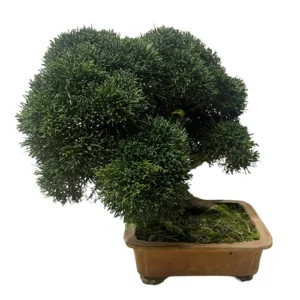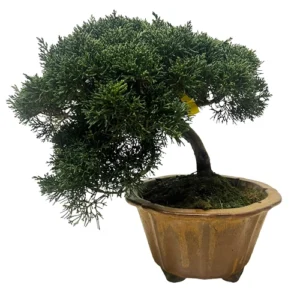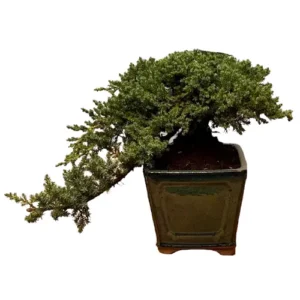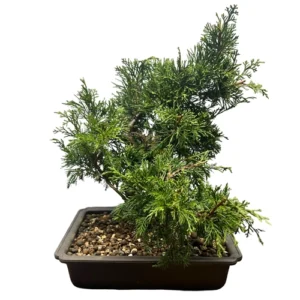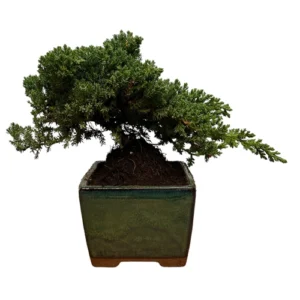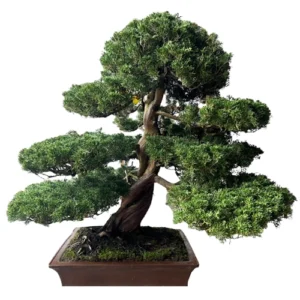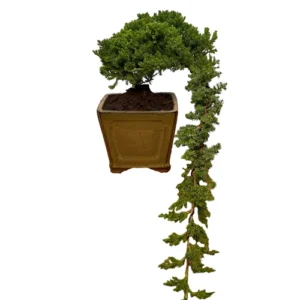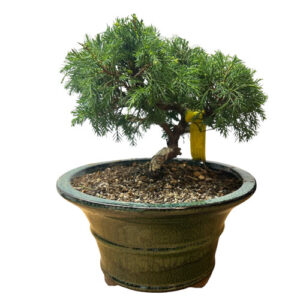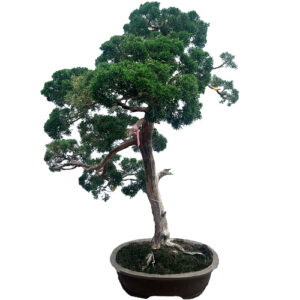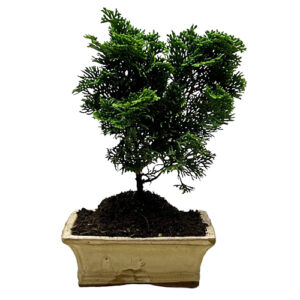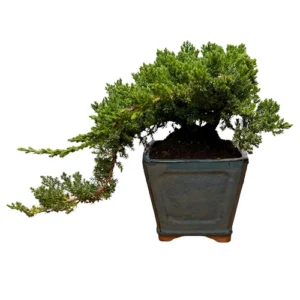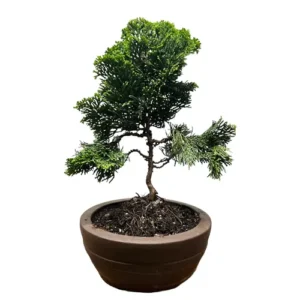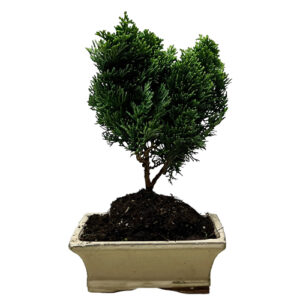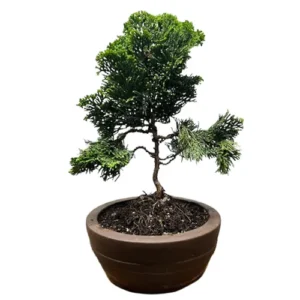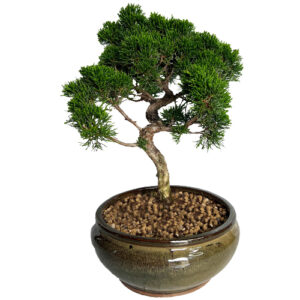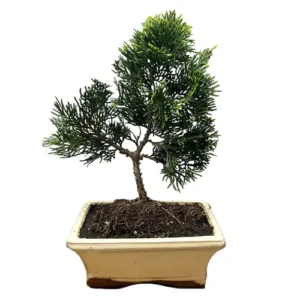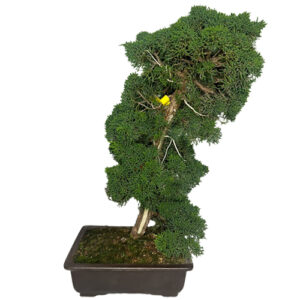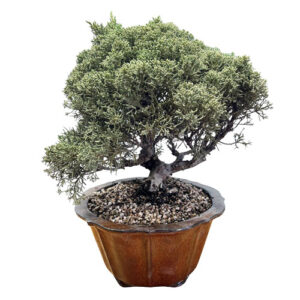Juniperus Chinensis
Juniper Bonsai
The juniper is one of the most popular bonsai trees. There are a huge variety of species under the name Juniperus, ranging from trees to shrubs and with scale-like foliage or needle-like. Junipers are native to many continents, from America to Europe to Asia. They are evergreen and have an attractive silhouette when shaped well.
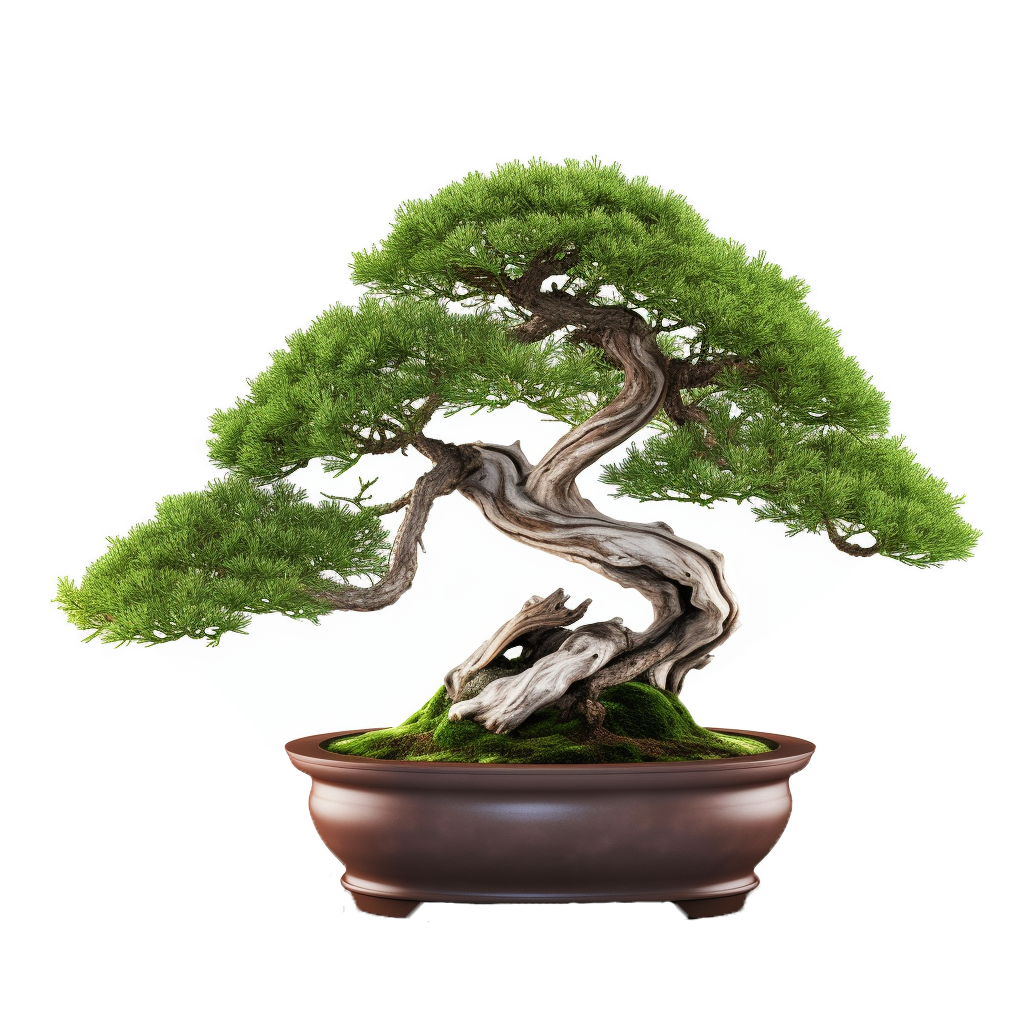
Juniper Bonsai Care Guidelines
Placement
Choose an outdoor location that receives full, direct sunlight. Junipers are very hardy but should not be kept indoors and need to be protected from temperatures below -10 °C. If you anticipate freezing temperatures, you should move your juniper tree to a cold frame, unheated greenhouse or conservatory, or consider providing insulation during winter. It is part of the juniper’s internal frost protection mechanism for its leaves to turn a purplish brown but they will turn green again in the springtime.
Watering
There is no definitive guide to watering and it should be conducted on an observational schedule, not a routine. This means that it is important to keep an eye on the moisture levels of the soil to avoid over and under watering, both which can lead to dropping leaves and/or root death. The amount of water a bonsai requires depends on pot size, climate, airflow, soil and tree type so it is best to use your eyes and fingers to assess whether the soil is damp, wet or dry.
If the top inch or so of soil has dried, it is ready to be watered. When you water, try to get an even coverage over the roots and soil, allowing water to flow out from the bottom of the pot to ensure a good soaking.
If you are a first-time bonsai owner, another way to water is by submerging the entire pot in water until the bubbles stop. If you choose this method, be aware that your bonsai may not need watering for another two to four days, but this will depend on the factors mentioned above such as soil type, pot size and climate.
Accidental overwatering of junipers is a very common problem so ensure that your tree is placed in a well-draining soil mix and that the soil is just damp, never wet.
Feeding & Fertilising
Using fertiliser on your juniper will help encourage healthy growth and this should be done periodically from once a week to every two months and only during the growing season. You can start adding Chrysal Liquid Bonsai Feed to your water from March until October and use weekly. Use Naruko Fertiliser Slow Release Bonsai Feed once every one to two months. With Buddhist Pine trees, less is more, and we tend to advise using half the recommended dosage to see how your Buddhist Pine reacts first.
Pruning & Wiring
Pruning your bonsai is important not only to maintain or create an aesthetic style but to also ensure light and airflow can reach inner leaves. Throughout the growing season, you can trim or pinch back long shoots that stick out from the shape of the tree. While the juniper can withstand some aggressive pruning, bear in mind parts of the trunk and branches that have had all foliage removed will not grow back so leave some growth on parts you want to keep alive. It is also worth noting that the growing tips of juniper foliage are located at the tops of stems so it is imperative to avoid trimming the tree like a hedge as this will weaken the tree significantly and lead to browning needles.
Training your bonsai using wiring is certainly possible with this species of bonsai, and the juniper can withstand aggressive bending of the branches but be careful to protect the bark with raffia or tape to avoid scarring and wounds. When they become dense, the inner parts of the foliage pads can die due to a lack of light and air. Mitigate this by thinning them as well as manipulating them to fan out using wire. We recommend using wires with a thickness that matches the thickness of the branch: if the wire you choose is too thick you will damage the bark. If it is too thin, it won’t be effective.
Repotting
Repotting your tree is an important way to provide a fresh and suitable soil mix and ensure appropriate root health. Repot in early spring. Generally, your juniper will need to be re-potted once every two years if it is young, while older ones can stay in their pots for longer. However, you should always check if it has become root-bound before you change pots. You can do this by lifting the tree gently out of the pot by the main trunk and examining the root system. You will know it is ready if you can see that the roots are circling around each other and the pot. If, however, they still appear contained in the soil, you should place it back and wait until the following spring to check again.
Trees that are ready for repotting will require root pruning, a suitable new pot and appropriate soil mix.
When repotting, do not cut back the root mass by a large amount, and choose a well-draining soil mix that has a neutral or slightly higher PH value of 5-6 but not over 7. We tend to use a mixture of different speciality bonsai soils on our trees. Every species is different so please contact us for free soil-mix advice or to take advantage of our repotting service.
Bonsai trees aren’t only magnificent additions to an indoor oasis, they are more than capable of standing out in any garden. Many Bonsai species are incredibly hardy and withstand nature’s colder and damper turns with aplomb making them worthwhile outdoor plants. We have an extensive library of care guides for outdoor bonsai trees. It’s not about selecting the perfect bonsai, it’s about selecting the perfect bonsai for you.
Juniper Bonsai - Typical Queries
How many types of Juniper Bonsai trees are there?
There are over 50 species of juniper trees, and many of them can be used to create Juniper Bonsai trees. Some of the most common and popular types of Juniper Bonsai trees are the Chinese Juniper, the Japanese Shimpaku Juniper, the Japanese Needle Juniper, the Japanese Garden Juniper, and the Rocky Mountain Juniper.
Do Juniper Bonsai like to be misted?
Misting a Juniper Bonsai is not necessary, as it does not increase the humidity or moisture level of the tree. Misting can be harmful, as it can cause fungal infections, needle browning, and leaf drop. Instead of misting, it is better to provide adequate watering, drainage, and ventilation for the Juniper Bonsai.
What are the common pests and diseases of Juniper Bonsai?
Juniper Bonsai trees are generally resistant to pests and diseases, but they can still be affected by some common problems, such as spider mites, scale insects, aphids, fungal infections, and root rot. These pests and diseases can cause symptoms such as yellowing, browning, or dropping of needles, sticky or white spots on the foliage, and wilting, or decay of the roots. To prevent and treat these problems, it is important to keep the Juniper Bonsai in good health, by providing adequate watering, sunlight, soil, pruning, and fertilizing. It is also advisable to inspect the tree regularly and use organic or chemical pesticides or fungicides if necessary.


